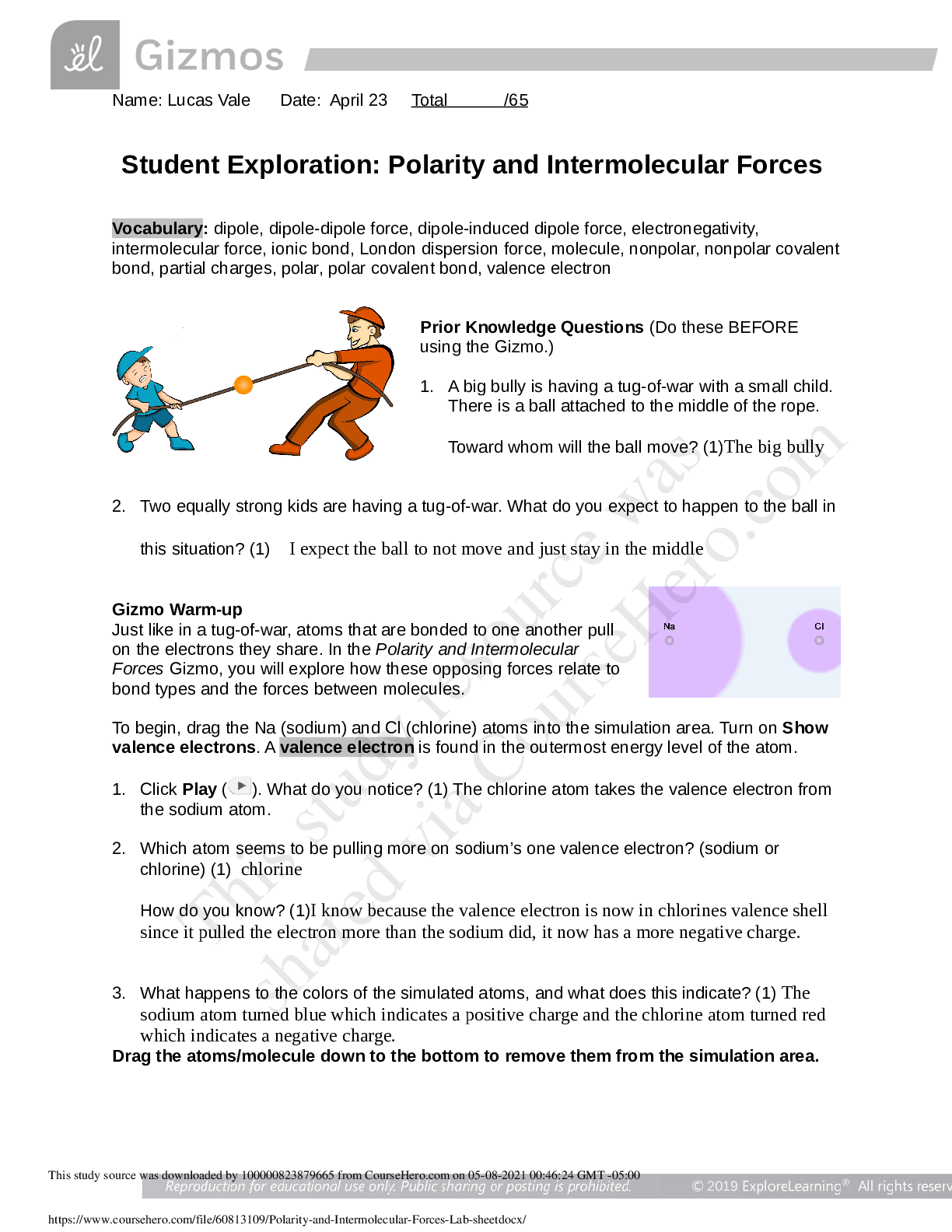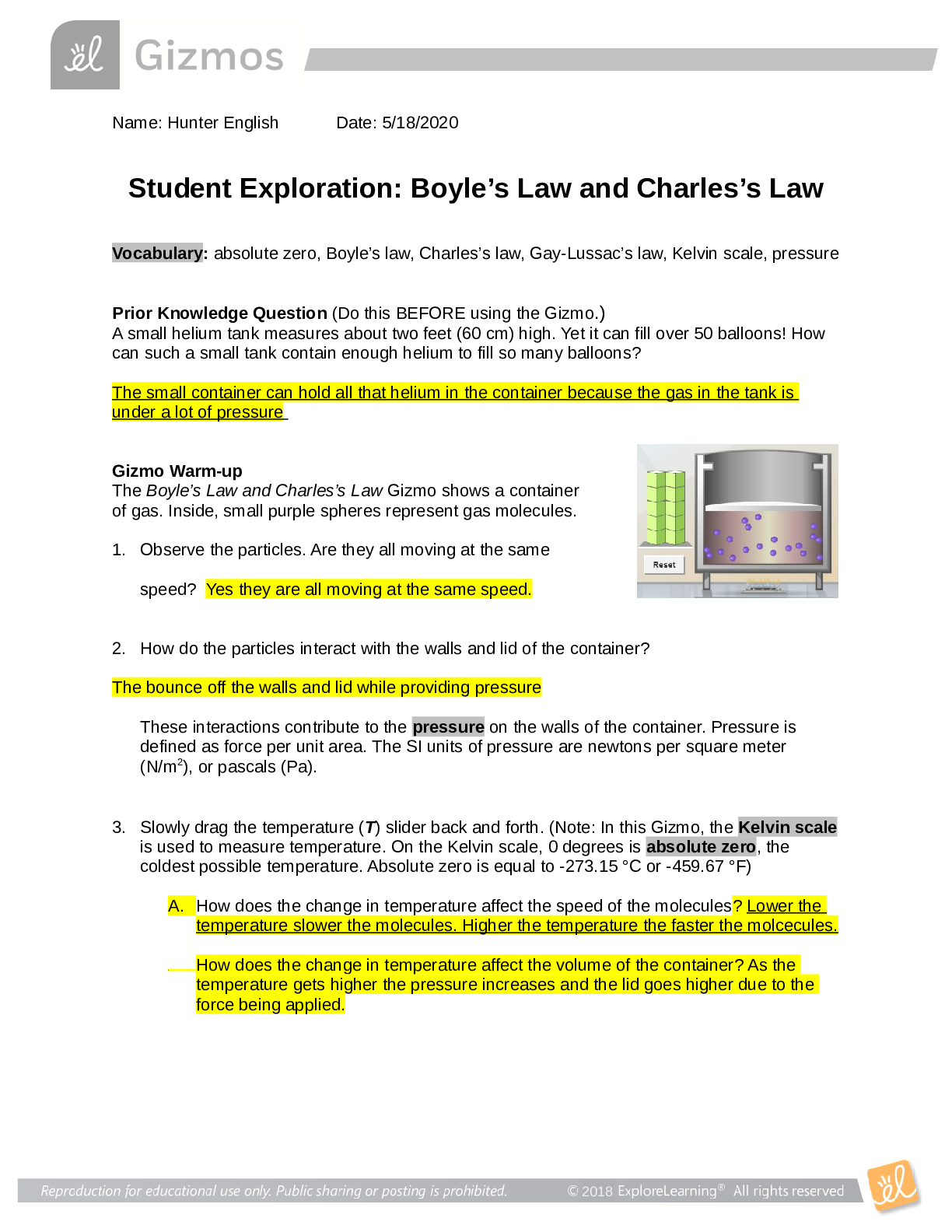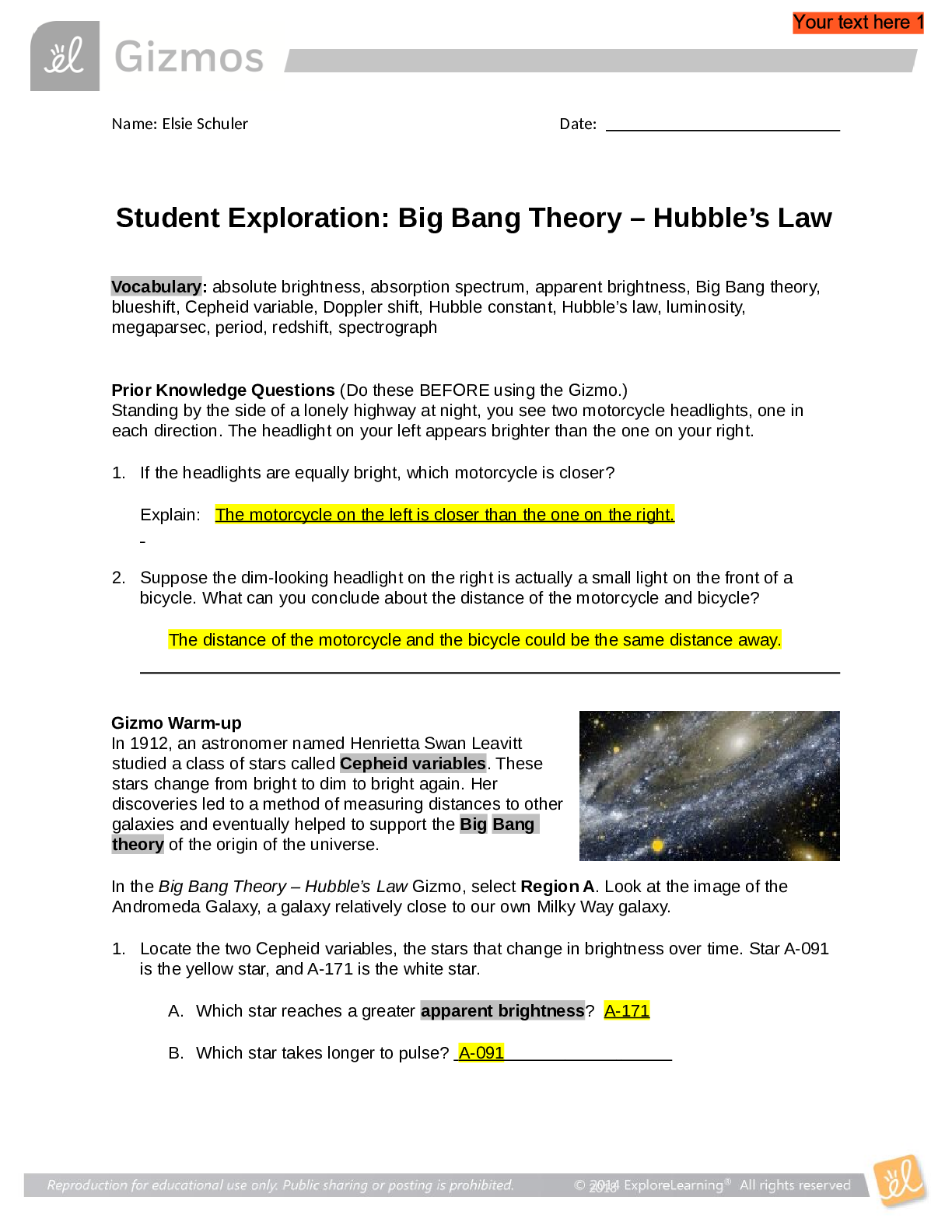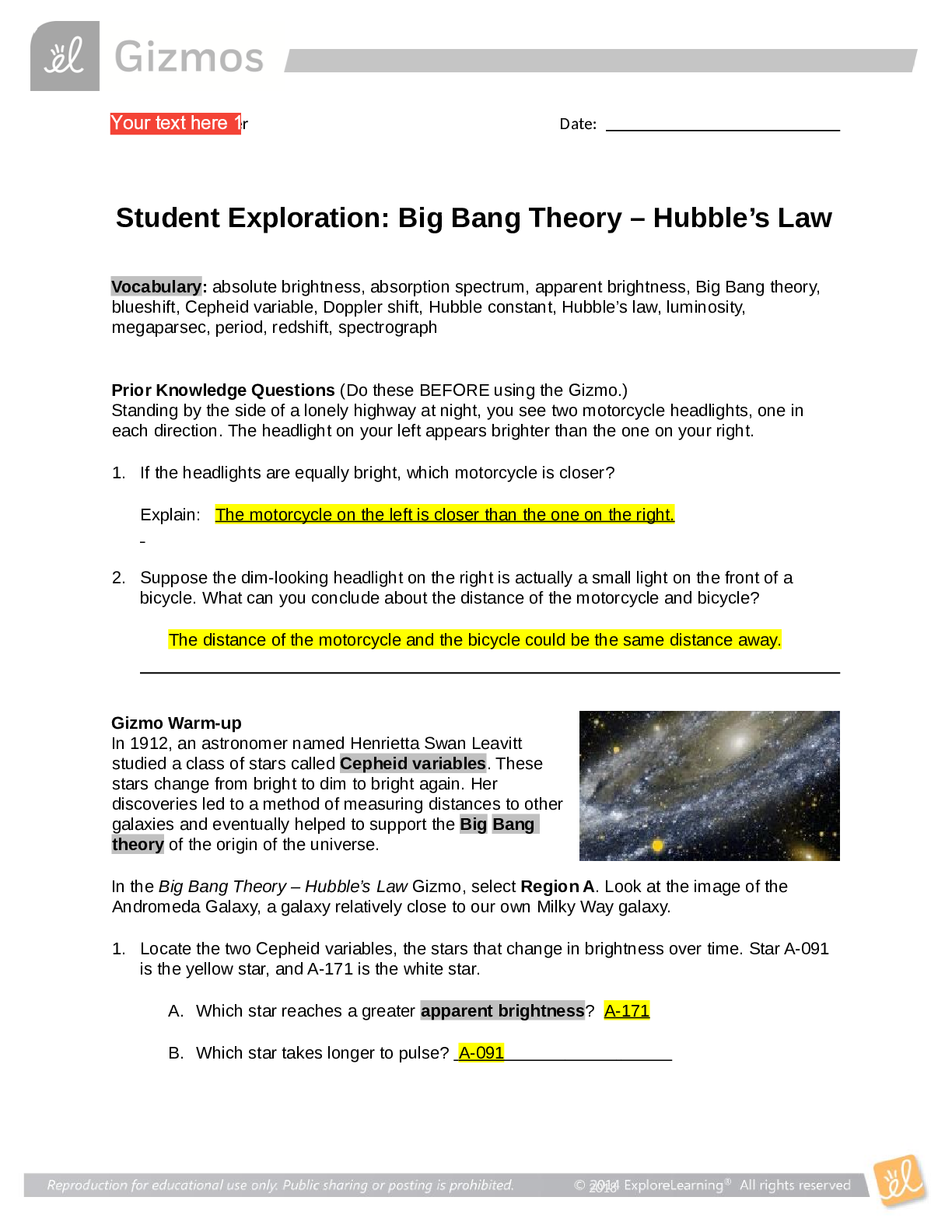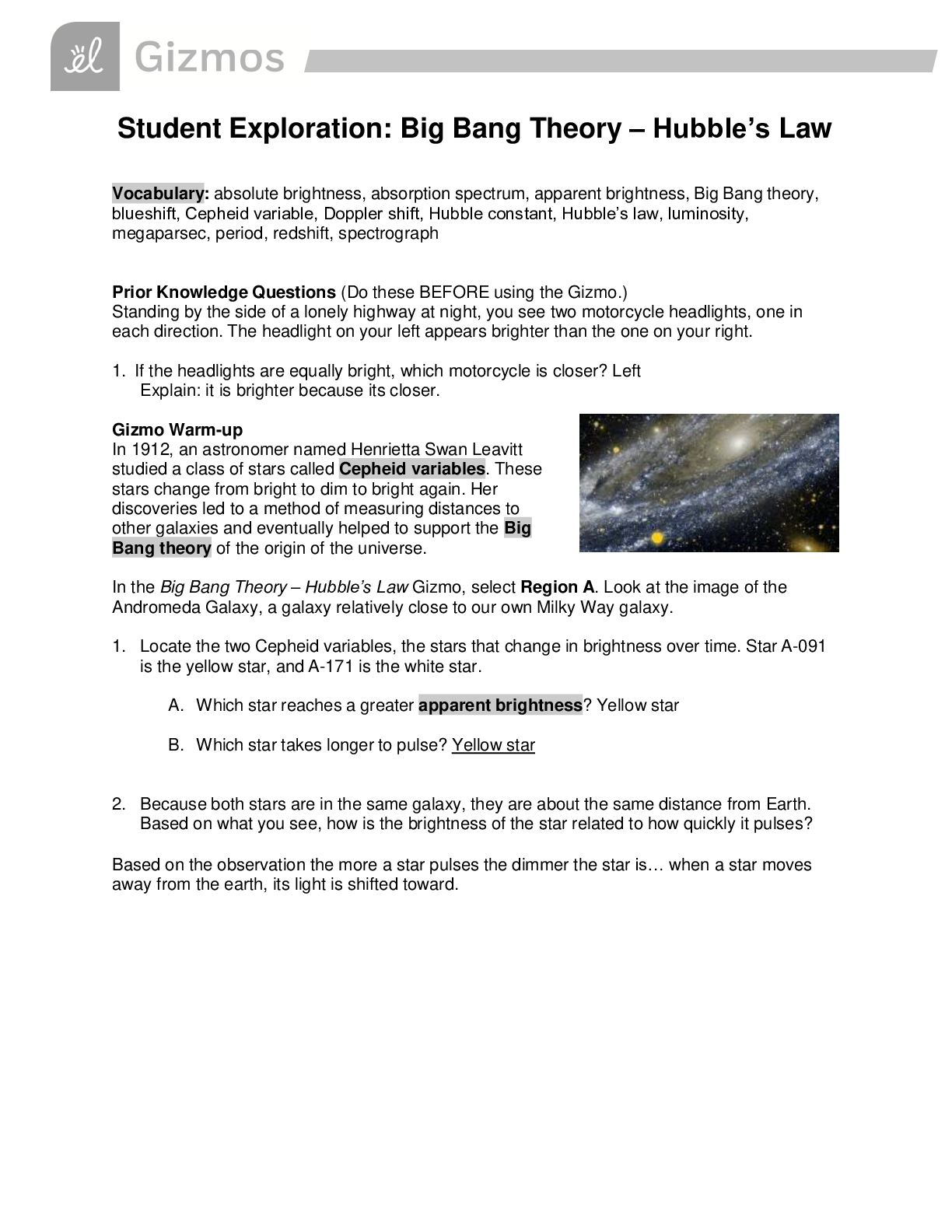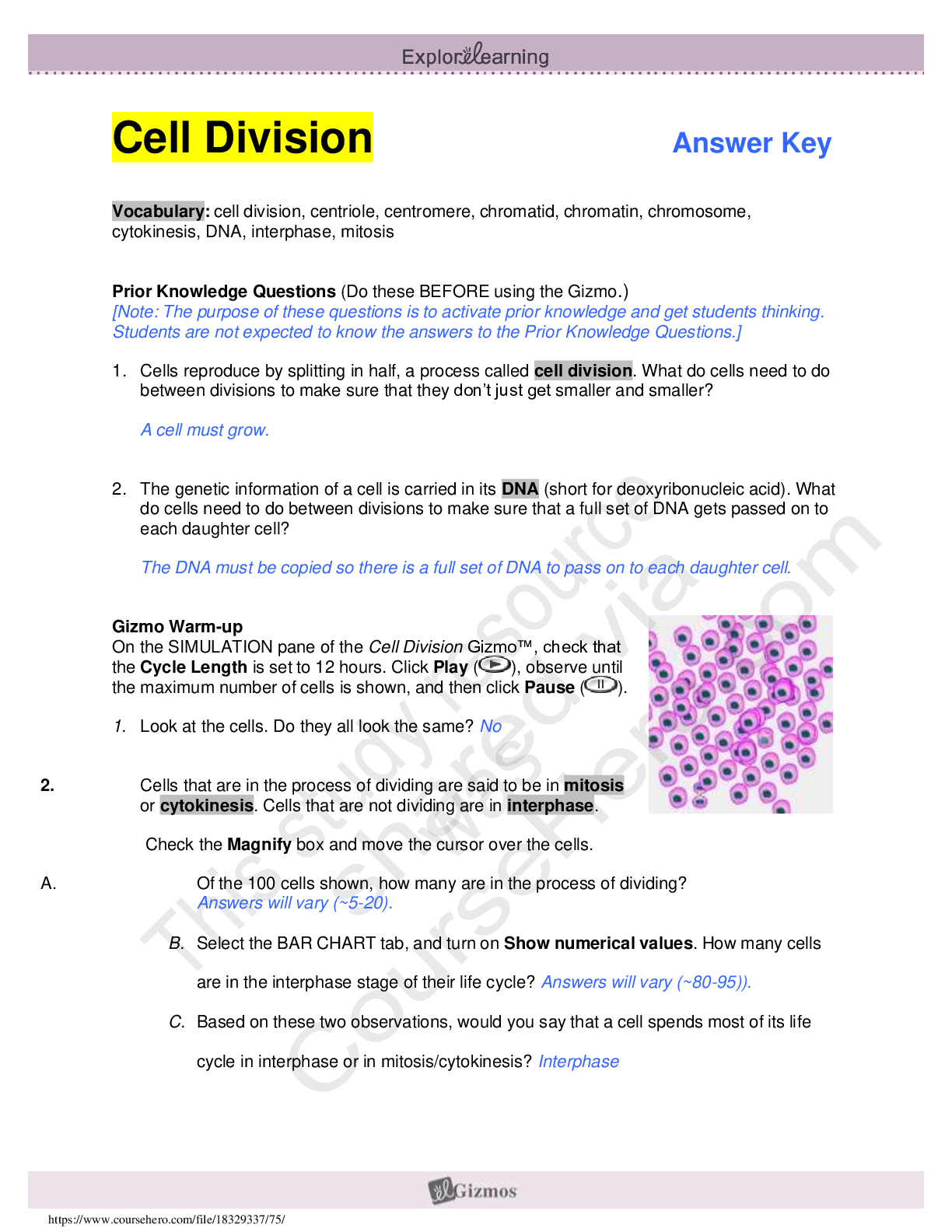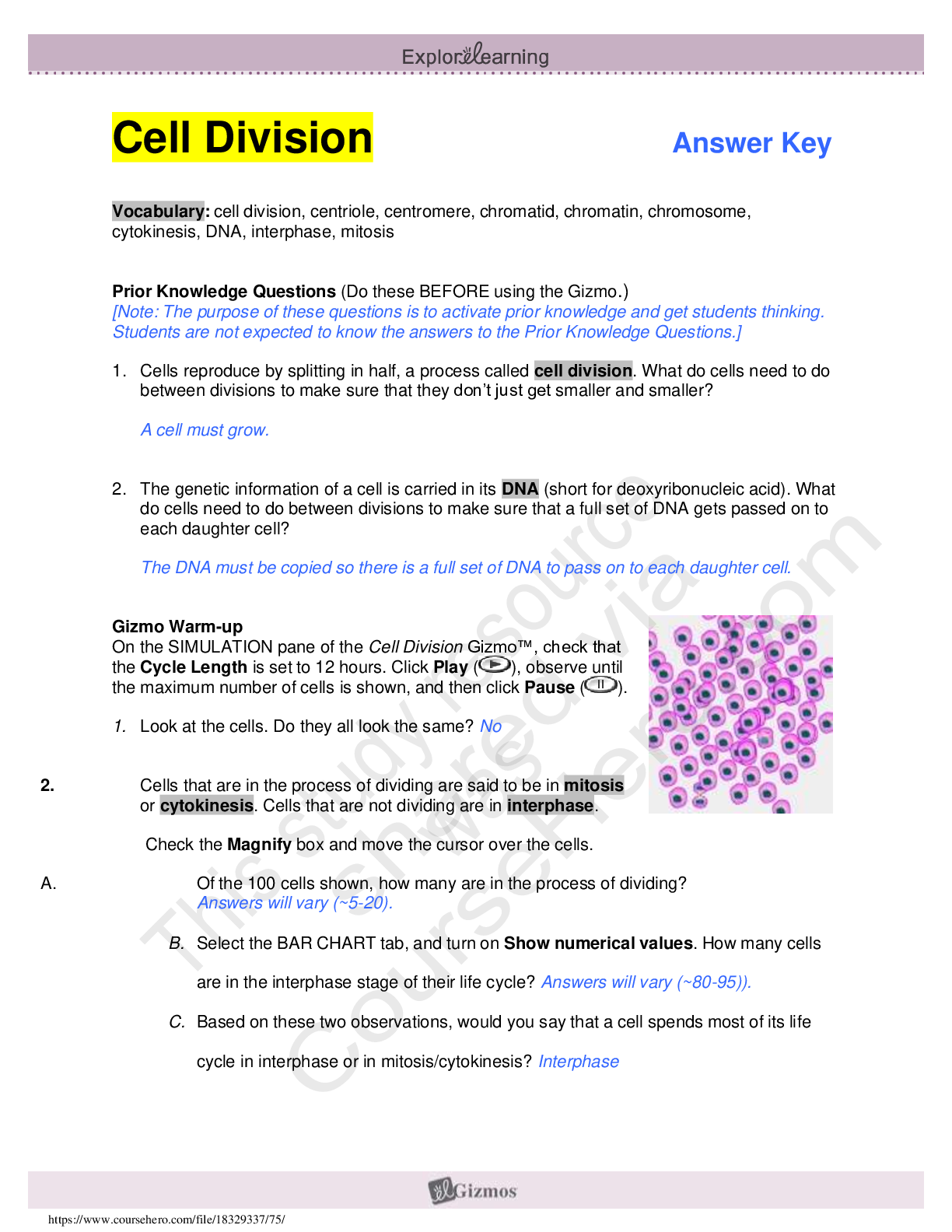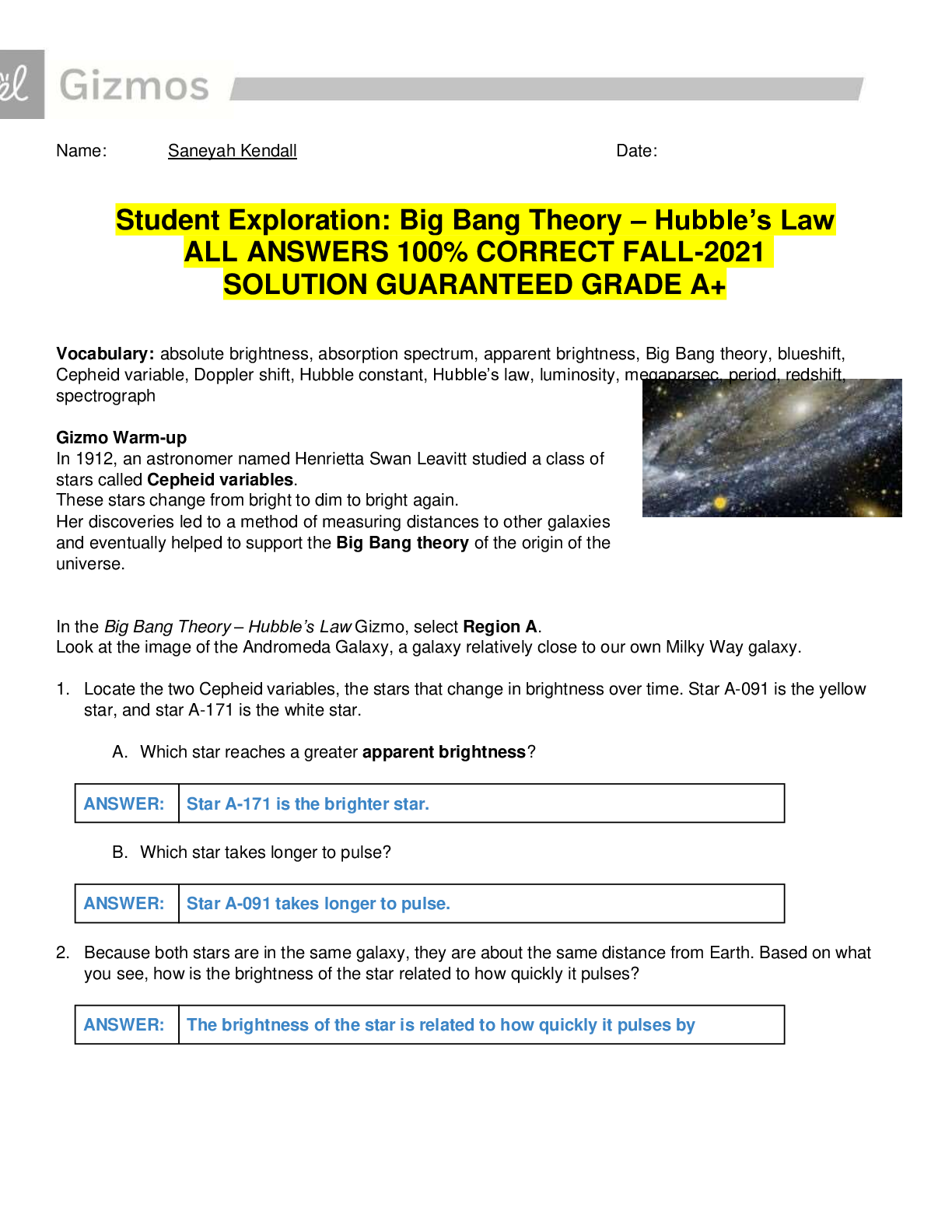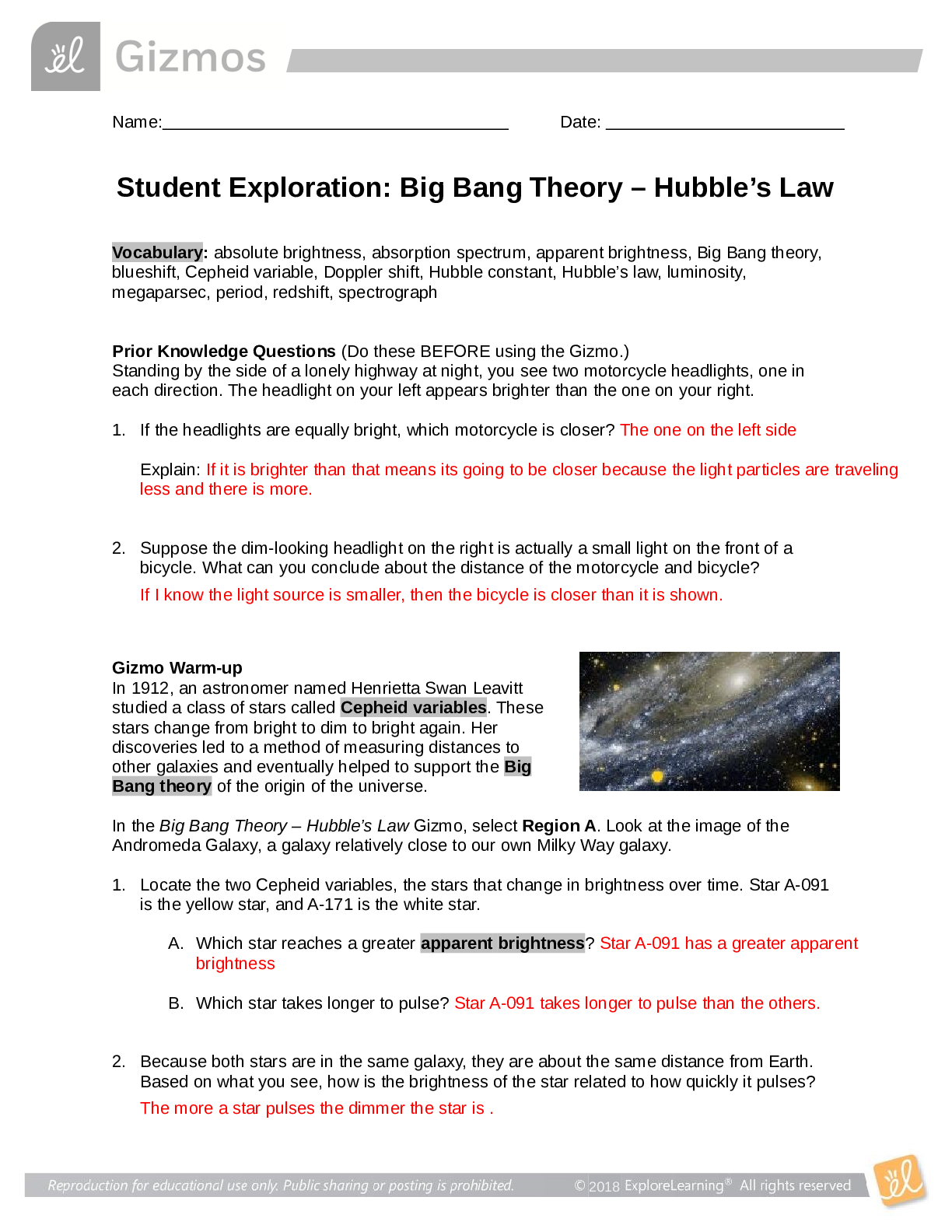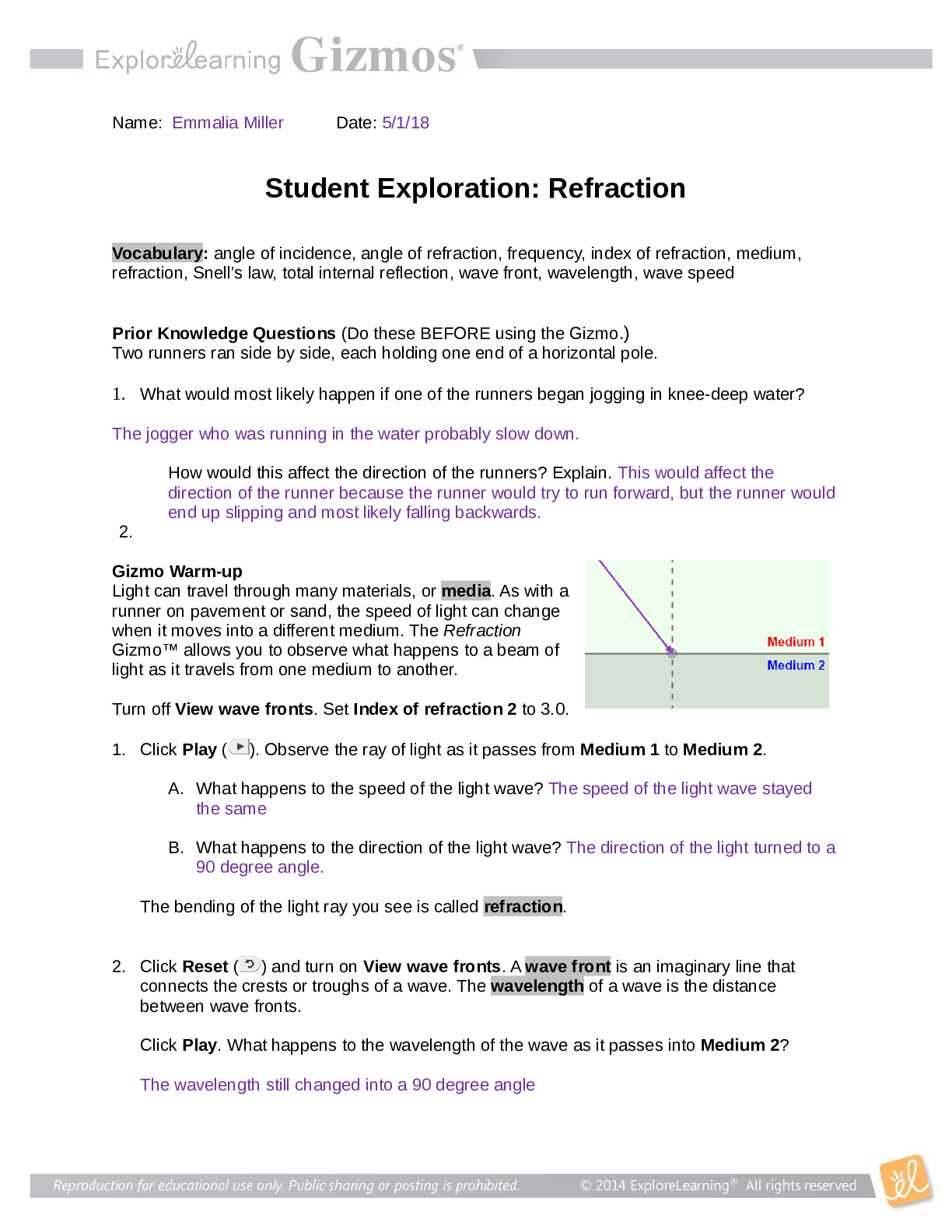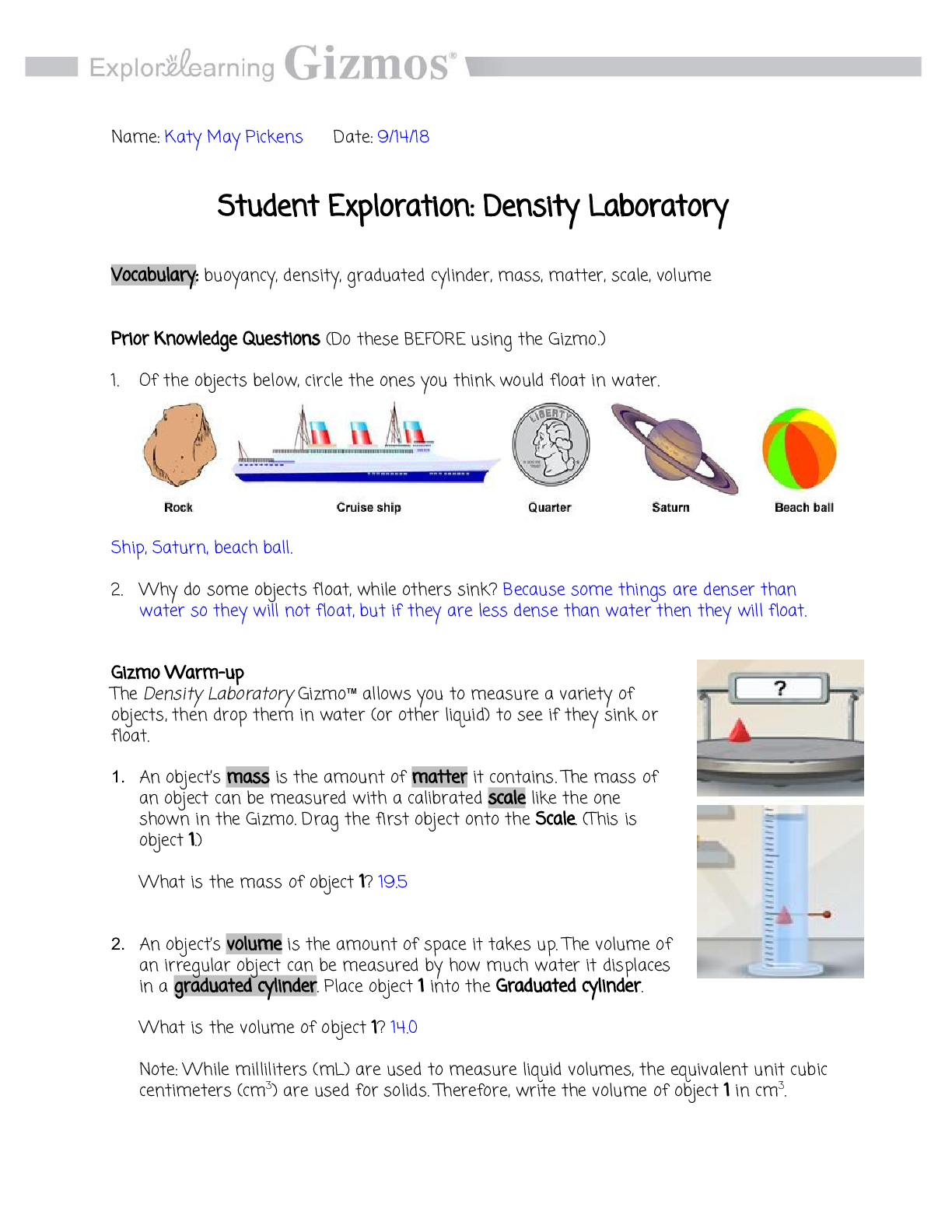Gizmo Reaction Energy Student Lab Sheet( Complete Solution Rated A)
Document Content and Description Below
Name: Date: Student Exploration: Reaction Energy Vocabulary: calorimeter, chemical bond, endothermic, enthalpy, exothermic, Hess’s law Prior Knowledge Questions (Do these BEFORE u... sing the Gizmo.) 1. Two magnets are stuck together. What might you have to do to get them to separate? Pull them apart 2. Suppose you held two magnets a short distance apart, then let go. What would happen? If opposite poles they would stick together, but if they were the same, they’d spin away from each other 3. Think about the magnets in terms of energy. In which case do you increase the potential energy of the magnets? In which case do you increase the kinetic energy of the magnets? The further they are apart, the higher the potential energy. When a magnet moves an object, it turns to kinetic energy. Gizmo Warm-up Just like magnets, atoms of different elements are attracted together to form chemical bonds. Breaking these bonds requires energy. When a new bond forms, energy is released and temperatures rise. In the Reaction Energy Gizmo™, you will explore how the energy of chemical bonding relates to temperature changes that occur during chemical reactions. To begin, check that Reaction 1 and Forward are selected. In this reaction, hydrogen (H2) and oxygen (O2) react to form water (H2O). The reaction takes place inside a device called a calorimeter. Inside the calorimeter, a small chamber holds the reactants. The rest of the calorimeter is filled with water. 1. Click Play ( ). What happens? All of the molecules bonded and made H2O 2. How does the temperature change? It increases during the reaction from 21 C-26 C Introduction: The heat energy stored in a chemical system is called the enthalpy (H) of the system. When atoms are joined by a chemical bond, energy must be added to pull them apart. This increases the enthalpy of the system. When a chemical bond forms, energy is released as shared electrons move into lower-energy orbitals. This causes the enthalpy to decrease. Question: How can you predict how much energy is released in a chemical reaction? 1. Predict: In the warm-up activity, you observed how the reaction inside the chamber affected the temperature of the surrounding water. Based on what happens to the surrounding water, do you think heat energy (enthalpy) is absorbed in the reaction or released? Explain. I think enthalpy was released and will increase, because energy was released in the form of heat 2. Observe: In the Gizmo, the energy required to break a chemical bond is modeled by placing a molecule into a set of mechanical claws. Place one of the hydrogen (H2) molecules between the claws, and press Break bond. A. What happens? It broke apart, and energy was absorbed B. Look under the Energy absorbed column of the table. How much energy was required to break this bond? 436 kj/mol Note: The energy is given here in units of kilojoules per mole (kJ/mol). This is the energy, in kilojoules, required to break all of the H–H bonds in one mole of H2 gas. C. Remove the hydrogen atoms from the claws and then break apart the other H–H molecule. What is the total energy absorbed so far? 872 kj/mol 3. Measure: Notice that the oxygen atoms are connected by a double covalent bond. This is because the oxygen atoms share two pairs of electrons. Place the oxygen molecule in the claws and press Break bond. A. How much energy is required to break the first O–O bond? 349 kj/mol B. Press Break bond. How much energy is needed to break both bonds? 495 kj/mol C. What is the total energy required to break up two moles of H2 molecules and one mole of O2 molecules? 1367 kj/mol (Activity A continued on next page) Activity A (continued from previous page) 4. Create: Remove the two oxygen atoms from the claws. Now the claws disappear and you see a template for creating a water molecule. Drag an oxygen and a hydrogen atom into the template. (If necessary, use the Key on the right-hand side as a reference.) A. Click Create bond. What happens? They bond, and energy is released B. The “jiggling” animation you see represents the release of kinetic energy that occurs when a bond is formed. How much energy was released? 463 kj/mol C. Drag another hydrogen molecule into the template and click Create bond to make a water molecule. What is the total energy released so far? 926 kj/mol D. Drag the first water molecule away from the template, then use the Gizmo to create a second water molecule. What is the total energy released now? 1852 kj/mol 5. Calculate: Compare the energy absorbed in breaking up the molecules to the energy released when new bonds are formed. A. In this reaction, was more energy absorbed or released? Released B. How does this relate to the change in temperature observed for this reaction? The temperature decreases more than it increases C. The change in enthalpy (∆H) of the system is equal to the total energy absorbed minus the total energy released. What is the ∆H value for this reaction? -485 Compare this value to the Theoretical ∆H listed on the right side. 6. Draw conclusions: The experimental ∆H value was determined by measuring how much heat the reaction produced inside the calorimeter. This is calculated based on the temperature change of the reaction, the amount of water inside the calorimeter, and the specific heat of the calorimeter. Compare the theoretical change in enthalpy to the experimental value. Are these values close? Yes they are only one kj apart. Introduction: Reactions that emit heat energy are called exothermic reactions. In an exothermic reaction, more heat energy is released by the formation of bonds than is absorbed in the breaking of bonds. In an exothermic reaction, the temperature of the surroundings will increase and the enthalpy of the system will decrease as energy is emitted from the system. In an endothermic reaction, more heat energy is absorbed in the breaking of bonds than is released in the formation of bonds. The temperature decreases and the enthalpy increases. Question: How can you predict the direction of a chemical reaction? 1. Observe: Notice that in the reverse reaction, the container is filled with water molecules. A. Click Play. What happens? Nothing B. Did the temperature change? No C. Is there any evidence that a reaction took place? No Explain. The reaction chamber still contains 0.2 mols of H2O 2. Investigate: Switch to the INVESTIGATION tab. Use the claws to break up the two water molecules, and then form two hydrogen molecules and one oxygen molecule. A. How much energy was absorbed in breaking up the water molecules? 463 kj/mol B. How much energy was released in forming the product molecules? 436 kj/mol C. What is the total enthalpy change in the system? 27 D. Based on this result, is this reaction exothermic or endothermic? Endothermic Explain. It takes more energy in that releases, which means it is endothermic. Most endothermic reactions do not occur unless there is a continuous input of energy. For example, water molecules can decompose into hydrogen and oxygen gas by adding a salt and passing an electrical current through the water. (Activity B continued on next page) Activity B (continued from previous page) 3. Investigate: Select Reaction 2. On the INVESTIGATION tab, go through the reaction in both the forward and reverse directions. State the energy absorbed, energy released, and theoretical ∆H value in each direction: Direction Energy absorbed Energy released Theoretical ∆H Forward 926 kj/mol Reverse What do you notice about the theoretical ∆H values in the forward and reverse directions? 4. Predict: Based on your findings, do you think Reaction 2 is more likely to occur in the forward or reverse direction? Explain. 5. Test: Select the REACTION tab and test your prediction by running the reaction in the forward and reverse directions. Describe your findings. When the reaction occurred, how did the theoretical ∆H value compare to the experimental value? 6. Investigate: On the INVESTIGATION tab, go through the remaining reactions, in either direction. (You will only need to look at each reaction once.) Fill in the table, then predict if the reaction will proceed in the forward or reverse directions. Reaction Direction Theoretical ∆H Forward or reverse? 3 4 7. Test: Test your predictions on the REACTION tab. What did you find? Introduction: Each chemical bond has a “bond enthalpy” that describes how much energy is absorbed to break a bond and how much energy is released when the bond is formed. (These values are the same.) A chart of bond enthalpies for some common bonds is shown below. Bond Enthalpy (kJ/mol) Bond Enthalpy (kJ/mol) Bond Enthalpy (kJ/mol) C–H 413 O–H 463 H–H 436 C–C 348 O=O 495 N–H 391 C=C 614 O–S 265 N≡N 941 C=O 799 O=S 523 S–S 266 Question: How can you use bond enthalpy to predict the total enthalpy change of a chemical reaction? 1. Calculate: Consider the reaction CH4 + 2O2 → CO2 + 2H2O. A. In the reactants, how many C–H bonds are there? B. Using the chart above, what is the total bond enthalpy of these bonds? C. How many O=O bonds are there? D. What is the total enthalpy of these bonds? E. What is the total bond enthalpy of the reactants? F. Do the same calculation for the products of the reaction, CO2 + 2H2O. Carefully count how many of each bond there is, and consider whether bonds are single or double bonds. Show your work and list the total bond enthalpy of the products below. Total bond enthalpy of products: G. Based on the enthalpy of the reactants and products, what is the ∆H value for this reaction? (Recall that ∆H = energy absorbed – energy released.) H. Use the Gizmo to check your results, and correct any errors if necessary. (Activity C continued on next page) Activity C (continued from previous page) Bond Enthalpy (kJ/mol) Bond Enthalpy (kJ/mol) Bond Enthalpy (kJ/mol) C–H 413 O–H 463 H–H 436 C–C 348 O=O 495 N–H 391 C=C 614 O–S 265 N≡N 941 C=O 799 O=S 523 S–S 266 2. On your own: Using the chart above, predict the enthalpy change for the following reactions. Show your work. A key of all relevant molecule structures is shown on the right. A. N2 + 3H2 → 2NH3 N2: N≡N H2: H–H NH3: Total ∆H: Exothermic or endothermic? B. 8SO2 → S8 + 8O2 SO2: O=S–O S8: 8 S–S bonds O2: O=O Total ∆H: Exothermic or endothermic? C. C2H4 + 3O2 → 2CO2 + 2H2O O2: O=O CO2: O=C=O H2O: H–O–H C2H4: Total ∆H: Exothermic or endothermic? 3. Analyze: In all of the reactions you investigated today, did it make any difference in which order you broke bonds or formed bonds? Explain your answer. According the Hess’s law, the total enthalpy change for a reaction is simply the sum of all of the individual enthalpy changes in the reaction. The order in which you add these enthalpy changes does not matter. [Show More]
Last updated: 1 year ago
Preview 1 out of 14 pages

Reviews( 1 )

by solufelo · 2 years ago
Document information
Connected school, study & course
About the document
Uploaded On
Apr 29, 2021
Number of pages
14
Written in
Additional information
This document has been written for:
Uploaded
Apr 29, 2021
Downloads
1
Views
435

